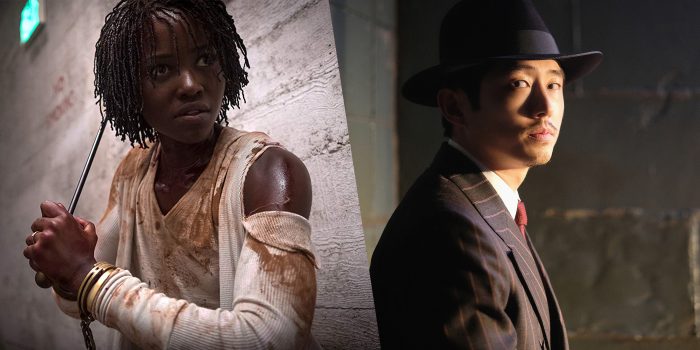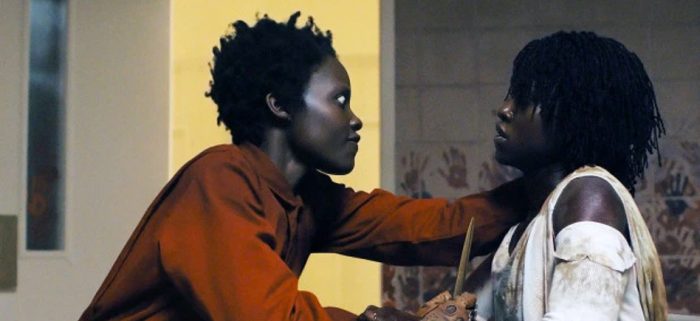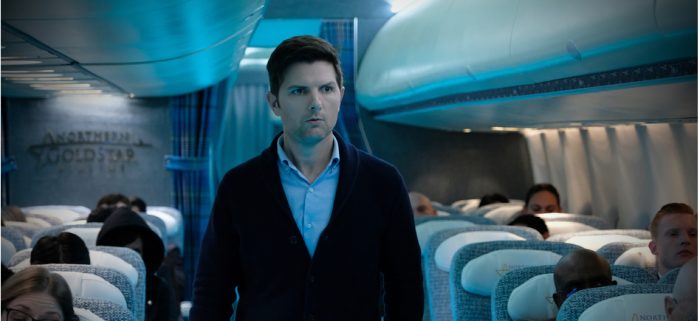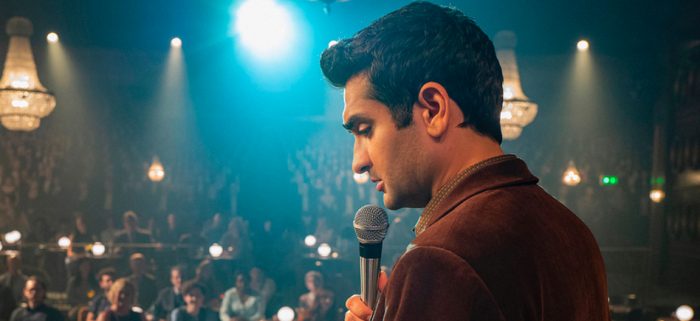
“The past is past,” a severely stressed-out man says to himself, staring in a cramped bathroom mirror. “The past….is past.” In spite of being encouraged to say this mantra by his therapist as a way to calm himself, it doesn’t work. That’s in part because the past is what you carry through to your present whether you like it or not. The notion of the past hovering over you as an inescapable force is a theme that runs rampant in a new film and a new TV show, both of which share the same creative mind: Jordan Peele.
First, there’s his gripping new horror film Us, and then there’s the revival of The Twilight Zone, on which he serves as host and executive producer. Though the opening mantra, “The past is past”, comes from one of the new Twilight Zone episodes, it’s just as applicable to what happens in Us.
This post contains major spoilers for Us and minor spoilers for the first several episodes of The Twilight Zone.

Mirror Images
In Peele’s new film, we follow the tense Adelaide (Lupita Nyong’o), her goofy husband Gabe (Winston Duke), and their children as they head to the beaches near Santa Cruz, California for a vacation getaway. Adelaide seems to be a naturally on-edge person, but she’s got plenty of good reason to be afraid of the trip itself. The last time she visited these beaches as a child, she had a traumatic experience in which she inexplicably encountered a doppelganger version of herself. Her innate concern turns into full-fledged terror when, the night the family arrives at their beach house, they’re beset upon by doppelgangers of themselves. Clad in red jumpsuits, with fingerless gloves and very sharp scissors, the doppelgangers (who call themselves the “Tethered”) desire to be untethered and aim to be as violent about achieving that goal as possible.
Us does not have a lot of easy answers as to why the Tethered exist, or how, or what they want to do upon escaping. If there’s anything that keeps the new film from being an equal to, or surpassing, Peele’s directorial debut, Get Out, it’s in the third-act storytelling being viscerally entertaining without seeming halfway as logical. The film is arguably designed to make you ask a lot of questions, to pore over every clue and to scratch your head over the handful of third-act twists. The mix of twists along with even a slight semblance of socially relevant issues peeking through the core of the film — Peele has talked about how Us is about recognizing that our fear of the Other is what he’s manifesting in the film, in much more direct terms than the film itself does — is what Peele is using to establish his credentials as a filmmaker.
When Us premiered at the South by Southwest festival a couple weeks ago in Austin, one of the earliest points of praise was from Variety’s Ramin Setoodeh, dubbing Jordan Peele the “new Spielberg”. That moniker has been applied before, famously to M. Night Shyamalan, another filmmaker who broke onto the genre scene with The Sixth Sense, a film that got Oscar nominations for Best Picture and Best Original Screenplay. (Just like Peele’s debut feature, Get Out, notably.) Though both Shyamalan and Peele have made films that build to surprise twists of a kind, the Spielberg comparison for Peele makes sense only to a point. The connection that does make much more sense is that Jordan Peele is, or wants to be, the next Rod Serling.

Exploring the Dimension of Imagination
Of course, by stepping into Serling’s shoes for the latest revival of The Twilight Zone, Peele is all but asking for that comparison to be made. In the new Twilight Zone, which premiered on April 1 via CBS All Access (I’ve seen the first four episodes), he strikes a fittingly enigmatic figure. Peele’s credited as “the Narrator”, as well as being an executive producer, though he’s notably absent as writer or director of the four available episodes. Peele instead invites you into this new, 21st-century-style take on Serling’s small-screen genre masterpiece. Each of the four episodes is frontlined by a recognizable actor — Kumail Nanjiani, Adam Scott, Sanaa Lathan, and Steven Yeun, respectively — and each of the episodes has some kind of supernatural twist of a kind. Yet even though Peele’s only directed two films, his sure hand behind the camera is missing.
That said, just as Us calculatedly name-drops the failed Hands Across America demonstration from 1986 as a way to bring to mind the notion of an ignored underclass in the United States, there are socially and culturally relevant elements to each new Twilight Zone episode. The original show was as concerned with pulling the rug out from audiences as it was about commenting on the state of the union, if not the world, in the early 1960s. From racial profiling and violence enacted by white cops to modern deconstructions of comedy and true crime, the new Twilight Zone is trying as much to be as surprising as the original show, as it is trying to remain relevant in a dark time.
In the premiere episode, titled “The Comedian,” Nanjiani plays a failing stand-up named Samir. Though Nanjiani’s no stranger to stand-up, Samir struggles to get his nightclub audience to pay attention, falling back on political humor that leaves the crowds silent. It’s only after Samir is encouraged by a comic icon (Tracy Morgan) to use personal details in his act that he gets laughs. But every time he mentions someone from his life, they vanish from existence. The episode grapples with the nature of laughter as filtered through the social-media landscape, the notion being Samir can only become popular by using his life as fodder for the content machine.
The next two installments — “Nightmare at 30,000 Feet” and “Rewind” — end up being the most eerily socially conscious. The former is a riff on one of the original show’s most famous stories, in which a shaken-up man is terrified to see a goblin on the wing of the airplane on which he’s flying even though no one else believes what he’s seeing. Taking over for William Shatner and John Lithgow (the latter of whom appeared in the film version, directed by George Miller) is the aforementioned Adam Scott, whose investigative journalist is trying to de-stress himself to little effect. Scott, so funny on Parks and Recreation and Party Down, is well cast as a well-meaning guy who just can’t stop scratching a mental itch.
That said, this version of the story takes a different turn, in an attempt to be more modern. Scott’s character, Justin Sanderson, indeed believes the flight he’s on is in grave danger, but not because of a goblin. Instead, Justin finds an old-school MP3 player with a true-crime podcast detailing the strange disappearance of a major commercial flight…the same one Justin is on. (It’s especially unnerving to watch this episode mere weeks after the Boeing scandal.) Now, Justin has to figure out who on the plane itself is going to cause a terrible disaster before it’s too late. In doing so, Justin ends up representing the worst impulses of modern Americans — he inevitably racially profiles (without trying to) a couple men wearing turbans, comes up against a fierce mobster and his crew, and only finds a friend in a mysterious passenger (Chris Diamantopoulos).
In “Rewind”, Lathan plays a loving but worried mother driving her teenage son to college. The simple act of filming him with an old-school camcorder turns into an unexpected travel through time: each time she rewinds the camera, time itself rewinds to an earlier point. Good thing, too, because a large and imposing patrolman (Glenn Fleshler) keeps bothering them, sometimes to the point of murdering one of them. In these two episodes, the past is what looms over the leads — for Justin, his past stresses in journalism are what lead him to so easily believe the impossibility of a strange podcast that knows his every move, and for Lathan’s character, it’s about her past with her estranged family that drives her to push her son to college.
“A Traveler”, the final available installment, is set at a remote outpost in Alaska as a local sheriff (Greg Kinnear) celebrates Christmas by pardoning one prisoner. He’s surprised to find someone who calls himself A Traveler (Yeun) in the prison who hadn’t been there before, and that character’s presence sets off a disturbing chain of events, in which Yeun’s nattily dressed, supposed YouTube presence can set others against each other by using their past as a weapon. There are only so many ways the story can end – this is true of each episode, honestly – and the final reveal is mostly what you might think after watching the first few minutes.

The Darkness of the Past
Past is what hovers over Us, as Adelaide describes her fears like a “black cloud” looming over her. She’s right to be worried, of course — the same doppelganger she encountered as a child has come to wreak havoc, and she’s brought friends. Though Peele’s physical presence in The Twilight Zone is welcome — and he’s physically present in each story, in a nice twist — he’s got much more on his mind in Us. Though he’s admitted to having been inspired by, fittingly, an episode of The Twilight Zone (“Mirror Image”), Peele’s digging deeper – literally. There are underground tunnels populated by rabbits, meant to evoke the countless miles of such tunnels underneath the United States; references to Hands Across America; and a general sense of displaced identity throughout the film.
In terms of inexplicably scary premises, Us is up there with something like Alfred Hitchcock’s The Birds. (In the same way that it’s easy to dub Peele the new Spielberg, you could easily see the influence of a suspense master like Hitchcock.) With The Birds, of course, Hitchcock deliberately avoids any sense of explanation: there’s no hint as to why birds are provoked into attacking people. They just…attack people, becoming more terrifying for lacking an explanation. Or in the case of another film quoted in Us, Stanley Kubrick’s The Shining, there are only teases of details about what happened at the Overlook Hotel all those decades ago before Jack Torrance brought his family there for the winter. Us takes things a step too far — when Adelaide’s double waxes philosophic about her theories as to how mankind somehow was able to copy the human body, it only raises more questions. As do the rabbits, and the sheer mass of doppelgangers, and their plans or lack thereof.
Each of the new Twilight Zone episodes has an element of the supernatural, from extraterrestrials to time travel. Knowing, for example, how it is that a podcast seems to materialize in Justin Sanderson’s seat, telling him what he’s going to do next, is more compelling than getting some kind of expository detail about how the hell it exists. And knowing that Kumail Nanjiani’s character is able to make characters disappear by using them as fodder for jokes is vastly creepier than knowing how he does this. With Us, we don’t get all the answers, but we get a sense that there are answers, making the impossible questions all the more frustrating.
But Us succeeds where, so far, The Twilight Zone is stumbling. In the case of the former story, it may have too much on its mind alongside some shocking third-act twists. (The very last twist in the film, in which we find out that the Adelaide we’ve followed through the film is actually the doppelganger, having forcibly switched places with the real Adelaide as a child, is very Twilight Zone-esque.) With The Twilight Zone, all there is are the twists that follow the setup. How did a prisoner appear in a cell out of the clear blue? How can a podcast predict a possible airplane crash? How can a comedian make people disappear by talking about them? The answers to these questions are less important than wondering how the new show will twist things around at the end, and there is a twist of some kind at the end of each episode. The problem is, that’s really all there is so far. The influence of Rod Serling is unavoidable in each of these pieces of culture; at least with Us, Jordan Peele dives deep into the story instead of just reverse-engineering it to surprise the hell of the audience.
The post Jordan Peele’s Revival of ‘The Twilight Zone’ Shares the Same DNA as ‘Us’ – Here’s How They Compare appeared first on /Film.
from /Film https://ift.tt/2Ibavyf
